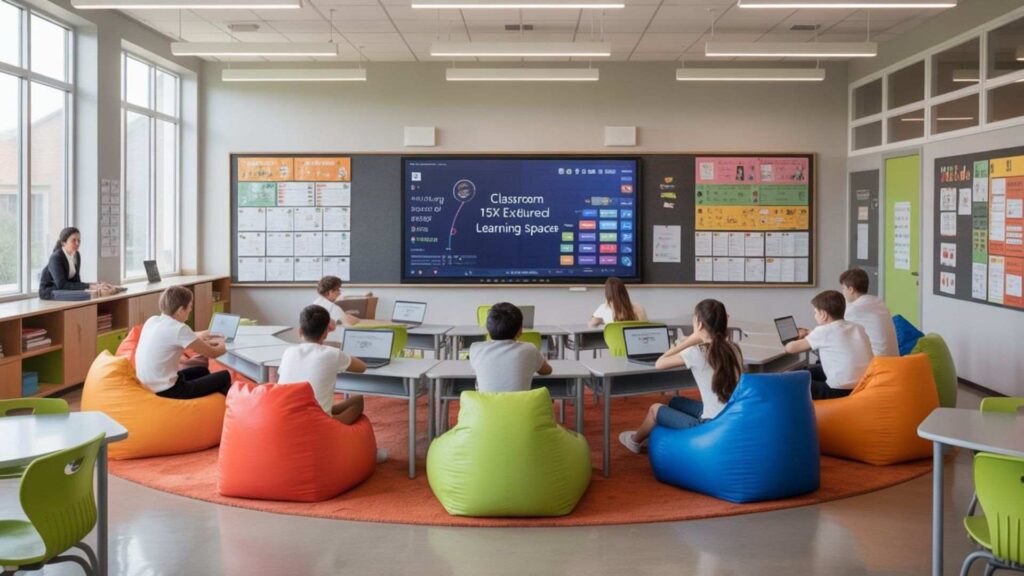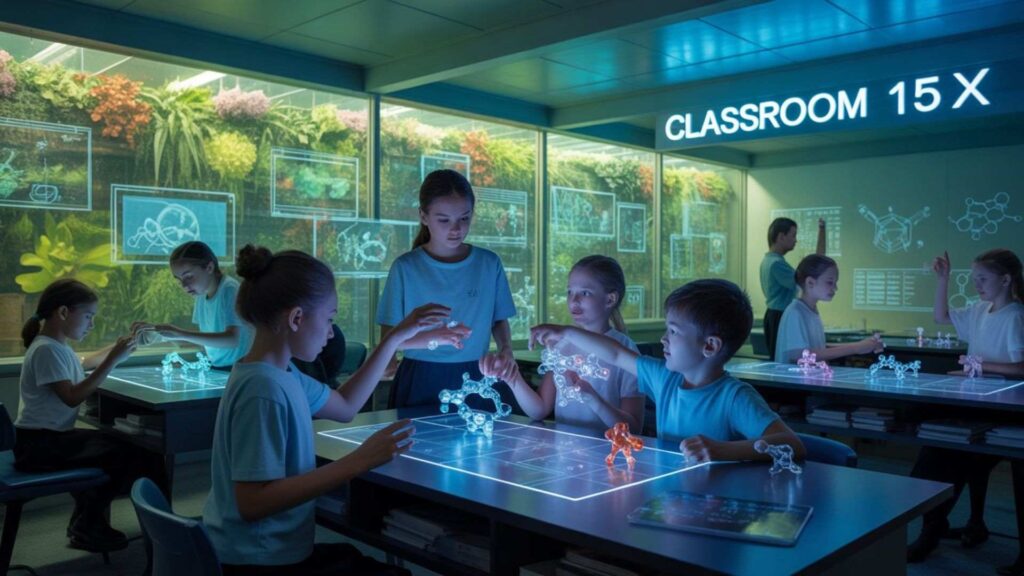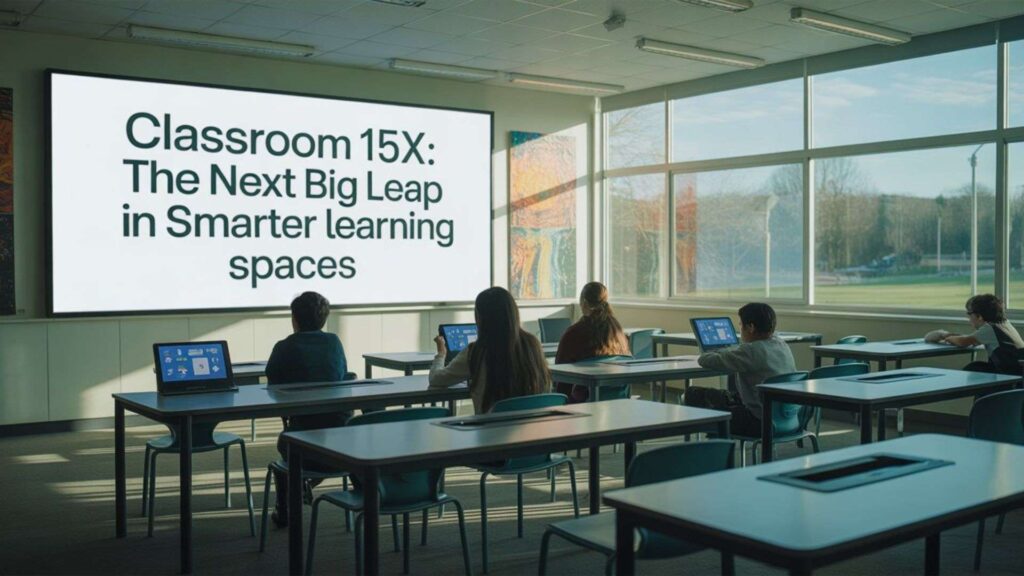The concept of classroom 15x is reshaping the way schools and universities think about teaching and learning. Unlike traditional setups, it focuses on creating innovative spaces where students gain more control, teachers access better tools, and institutions foster stronger engagement. By blending modern design, advanced technology, and adaptive strategies, classroom 15x moves far beyond static whiteboards or one-way lectures. It opens doors to flexible layouts, interactive solutions, and tailored approaches that fit diverse learning needs. This transformation isn’t just about new furniture or gadgets—it’s about building smarter environments that prepare learners for the future, ensuring better outcomes and lasting progress.
Classroom 15x Explained: The Future of Learning Spaces

The idea of classroom 15x is a groundbreaking approach that redefines modern classrooms into innovative hubs of learning. Instead of relying on traditional four-walled learning environments, this model uses interactive displays, immersive digital tools, and dynamic hubs of collaboration to enhance student engagement. The shift transforms ordinary spaces into conducive environments where students participate in meaningful collaboration and teachers use better tools to inspire progress.
By integrating flexible furniture, movable desks, and open layouts, schools can create innovative classroom environments that allow for student-led projects, peer teaching, and fun and interactive spaces. This model prioritizes interactive and comfortable learning, offering quiet zones, group zones, and focused learning areas. With access lessons anywhere, online sharing, and wearable devices, the future of learning becomes more resilient, ensuring students reach their full potential.
Core Principles Behind Every Classroom 15x Approach
At its core, classroom 15x thrives on innovation, adaptability, and student-centered learning. The use of adaptive tools, formative feedback, and integrated analytics tools helps teachers tailor lessons to individual needs. Through AI-driven simulations, science apps, and virtual reality, learners engage in hands-on lessons that foster problem solving, teamwork, and improved retention scores. These innovative ways ensure better student engagement and meaningful participation.
Another principle of this breakthrough education model is sustainable adoption. Institutions use modular design kits, streamlined setup, and customizable budgets to ensure scalability. Faculty influencers and alumni sponsorship often drive funding, while technical audits refine infrastructure. This balance of planning tools, professional development, and refined design results in formative environments that support both teachers and students.
Technology-Driven Classrooms Empower Smarter Student Learning
The modern classroom is powered by digital innovation. Tools like smartboards, digital whiteboards, and advanced AV equipment enrich lectures and support formative assessments. With cloud storage, online learning platforms, and collaborative document editing, students gain access to lessons anywhere while teachers streamline planning. High-speed connectivity makes interactive technologies more effective.
Additional features such as wearable devices, charging stations, and integrated software platforms enhance the classroom management system. This breakthrough innovation equips students for modern jobs and gives teachers efficient teacher tools for instruction and formative practices.
Flexible Designs that Adapt to Modern Education
The flexible design classroom focuses on physical adaptability. Breakout spaces take shape through movable partitions, adaptable furniture, and calm zones designed to support diverse learning styles. Whether for group work, quiet work areas, or interactive tools, these layouts support both focused learning and fun and active spaces.
Facilities teams manage acoustic challenges, climate control, and technical planning to provide increased comfort. This innovative classroom design creates resilient classrooms that adapt to resistant infrastructures. Through streamlined setup, schools achieve effective facilitation and improved student outcomes.
Student Engagement Strategies for Higher Participation
Classroom 15x strengthens student involvement through interactive technologies, peer-to-peer instruction, and student-led projects. These activities transform static presentations into fun and interactive spaces that keep learners motivated. Collaborative tables, group zones, and meaningful collaboration encourage major participation.
Through formative strategies and adaptive instruction, students gain ownership over the learning process. They not only remember lessons but also enjoy experiential learning. This approach boosts retention, inspires growth, and prepares students for global success.
Personalized Learning Experiences that Inspire Growth
Personalized learning paths and customized instruction are key features of classroom 15x. Using adaptive classrooms, teachers deliver personal attention at scale. Visual learners, writing learners, and kinesthetic learners benefit from custom learning plans that address individual needs.
With integrated analytics tools, schools implement tailored interventions, measure progress, and deliver successful outcomes. This formative success ensures students not only perform better but also grow into 21st-century learners ready for modern challenges.
Different Types and Models of Classroom 15x
| Type of Classroom 15x | Focus | Key Features |
| Tech-Based Classroom | New technology | Smartboards, learning apps, AI-driven simulations |
| Small Group Classroom | Personal attention | Around 15 students, peer teaching, focused learning |
| Flexible Design Classroom | Physical adaptability | Furniture on casters, modular furniture, open layouts |
| Fun & Interactive Spaces | Active participation | Student-led projects, hands-on learning, quizzes |
| Management System Classroom | Streamlined planning | Planning tools, integrated software platforms, formative feedback |
Why Classroom 15x Matters in Today’s Education
Classroom 15x matters because it reshapes pedagogy to focus on innovative design, adaptive instruction, and student-centered learning. The use of data-driven instruction and formative environments creates successful outcomes across schools, universities, and other institutions.
This groundbreaking model also prepares students for future opportunities by strengthening skills like problem solving, teamwork, and adaptability. By offering better classrooms, classroom 15x supports professional development, effective learning, and future-proof campuses.
Enhances Learning Outcomes Across All Age Groups
By integrating formative ecosystems and interactive tools, classroom 15x boosts performance in all learners. Younger students benefit from games and learning apps, while older learners thrive through AI-driven simulations and collaborative project submissions.
This transformative classroom pedagogy ensures resilient education where teachers apply formative teaching strategies to achieve successful outcomes.
Adapts to Individual Student Learning Styles
Classroom 15x respects diverse learning styles. Visual learners use interactive displays, writing learners rely on annotation tools, and kinesthetic learners engage in hands-on lessons. These different versions of instruction ensure no student is left behind.
By offering quiet work areas and group zones, schools create flexible layouts for students. This fosters better student engagement across all styles.
Simplifies Teacher Workflows and Classroom Management
For teachers, classroom 15x provides teacher tools like planning systems, quizzes, and integrated analytics tools. These features help plan and manage classes with ease. Formative assessments allow for quicker feedback and improved formative readiness.
This simplicity reduces workload, improves facilitation, and ensures formative success across classrooms. The system also supports scalable learning environments that adapt to customizable timelines.
Builds Future-Ready Skills for Global Success
The goal of classroom 15x is to prepare students for modern jobs and global success. Through transformative learning, students gain skills like teamwork, problem solving, and data-informed teaching strategies.
This innovative pedagogy provides future-proofing for both schools and universities. With better tools, learners achieve growth, adaptability, and confidence for tomorrow.
Practical Examples of Classroom 15x in Action
In one case study, a small group classroom using round tables with built-in charging saw a 20% rise in student participation. Another school using AI-driven simulations for science apps reported higher retention scores and course-completion rise.
Showcase pilot successes highlight how interactive technologies and streamlined setup increase student engagement. These success stories demonstrate how classroom 15x transforms classrooms into innovative learning labs with measurable outcomes.
Key Goals Driving the Classroom 15x Movement
The goal behind classroom 15x is simple: unlock students’ full potential. By combining teacher support, adaptive tools, and formative feedback, institutions achieve formative pathways that ensure growth.
A second goal is building resilient classrooms. Through breakthrough innovation, data-driven instruction, and flexible schooling, schools prepare students for the future while fostering meaningful participation and successful outcomes.
Overcoming Barriers When Adopting Classroom 15x
Challenges such as resistant infrastructures, budget constraints, and resistance to change often slow adoption. However, with grant funding, departmental budgets, and alumni sponsorship, institutions can ensure sustainable adoption.
Technical audits refine infrastructure, while faculty influencers and training sessions support professional development. These strategies reduce obstacles and ensure formative readiness in every classroom.
Inspiring Future of Education with Classroom 15x

The future of learning is driven by transformative power. With innovative classrooms pedagogy, classroom 15x builds adaptive environments that prioritize better ways to teach and better student engagement.
By investing in innovative design, resilient teaching, and groundbreaking innovation, institutions secure future-proof campuses. In these cutting-edge classrooms, students enjoy exciting learning while reaching their full potential.
Final Thoughts on the Classroom 15x Revolution
The journey of classroom 15x shows how education is moving toward smarter, more adaptable systems that go beyond traditional methods. By combining modern technology, flexible layouts, and student-centered strategies, it ensures higher motivation and more meaningful learning experiences. These environments promote active participation, improved academic outcomes, and scalable approaches that benefit both teachers and learners. While challenges like funding or resistant infrastructure remain, schools that embrace this change unlock long-term value. The true power of classroom 15x lies in its ability to prepare students for a changing world, offering a future where innovation, adaptability, and effective teaching shape lasting success.
FAQs About Classroom 15x
Q1: What is Classroom 15x in simple terms?
Classroom 15x is a groundbreaking approach that reimagines traditional learning by combining interactive tools, flexible design classrooms, and digital innovation. It creates an environment where students enjoy more engagement and ownership over the learning process.
Q2: How does Classroom 15x improve student engagement?
Through immersive digital tools, AI-driven simulations, and hands-on lessons, Classroom 15x encourages active participation. Students work in small group classrooms, use collaborative tables, and benefit from peer teaching, leading to meaningful collaboration and better outcomes.
Q3: Can Classroom 15x adapt to different learning styles?
Yes. It supports visual learners, writing learners, and kinesthetic learners with interactive displays, science apps, and virtual reality experiences. Its flexible furniture and movable partitions also help create quiet zones or breakout spaces for focused learning.
Q4: What technology powers Classroom 15x?
It uses advanced AV equipment, cloud storage, smartboards, wearable devices, and integrated analytics tools. These digital systems improve classroom management, help teachers track student progress, and offer more tailored instruction for different needs.
Q5: Why is Classroom 15x important for the future of learning?
Classroom 15x equips 21st-century learners with the skills required for modern jobs. Its transformative design promotes resilient education, scalable learning, and future-proof campuses. By blending innovative pedagogy with technology, it ensures students are prepared for global success.
Q6: What challenges come with adopting Classroom 15x?
Frequent obstacles arise from outdated infrastructures, budget limitations, sound-related issues, and reluctance to change within institutions. However, with faculty influencers, alumni sponsorship, and professional development, schools can achieve sustainable adoption and long-term success.
Q7: How can teachers benefit from Classroom 15x?
Teachers gain better tools like interactive whiteboards, planning tools, and streamlined classroom setups. They also enjoy effective facilitation, easier collaborative project submissions, and more formative feedback, helping them refine teaching strategies and support student growth.
ALSO READ:
Cricfooty: Live Scores, Breaking News & Ultimate Sports Hub
TheHRWP: Innovative HR Solutions to Empower Every Workforce
Mypasokey: Smart, Secure, and Simple Password Protection Guide

